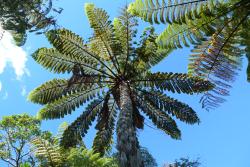Terrestrial ferns. Rhizomes rarely prostrate and creeping, or usually forming an arborescent trunk covered in adventitious roots and either persistent stipe bases or stipe scars; bearing scales at the apex. Fronds monomorphic (NZ), or sometimes slightly dimorphic (not NZ), not articulated to rhizome, sometimes with aphlebiae at the base (not NZ). Laminae rarely entire or 1-pinnate (not NZ), usually 2–4-pinnate (NZ), catadromous, herbaceous to coriaceous, bearing scales and hairs. Veins free. Sori round, borne on abaxial surface away from margins; paraphyses present; indusia either absent, forming a saucer-like structure at the base of the receptacle, forming a cup- or hood-shaped structure around the sorus, or completely enclosing the sorus and rupturing irregularly at maturity; receptacles slightly to strongly elevated, sporangia maturing in gradate sequence. Sporangia with slightly oblique annulus, 64 or 16 spores per sporangium. Homosporous; spores trilete; exospores sometimes pitted; perispores granulate, with coarse echinae or slender rodlets, ridged, or sometimes very thin; spores lacking chlorophyll.
A family of one genus, with about 500 species.
The phylogenetic relationships of the scaly tree ferns (Cyatheaceae), based on DNA sequence data from five plastid regions, were investigated by Korall et al. (2007). They recognised four major groups. Sphaeropteris, characterised by conform scales often bearing dark setae on the margins, and spores with an echinate perine, was shown to be sister to the rest of the scaly tree ferns, which comprised an unresolved trichotomy of three well-supported clades. Of the latter, Cyathea sensu stricto has marginate scales without an apical seta, and spores that have a pitted exine. However, the other two groups, Alsophila sensu stricto and Gymnosphaera, are less clearly separated morphologically. Both groups have marginate scales with an apical seta, and spores with a ridged perine, but Gymnosphaera has 64 spores per sporangium compared to 16 in Alsophila. Species of Gymnosphaera also often have slightly dimorphic fronds with reduced fertile pinnules, skeletonised pinnae (aphlebiae) at the base of the frond, and scales with pale, fragile margins.
Korall et al. (2007) discussed three possible options for classifying the taxa: i) four separate genera; ii) two separate genera (Sphaeropteris and Cyathea) with Cyathea divided into three subgenera; or iii) a single genus (Cyathea) divided into two or four subgenera. Smith et al. (2006) recognised four genera – Alsophila, Cyathea, Gymnosphaera and Sphaeropteris. However, the affinities of species in the Alsophila and Gymnosphaera groups have not all been investigated or determined, particularly in the Pacific region. Until species in this region are better understood, we prefer to accept a single genus, Cyathea.
The Cyatheaceae comprises terrestrial ferns that have arborescent trunks, or sometimes creeping or decumbent rhizomes, usually with large 2–4-pinnate fronds bearing scales and hairs. The sori are positioned away from the margin and vary from being unprotected to completely covered by an indusium at maturity. The sporangia have an oblique annulus and release trilete spores. The spores of all indigenous New Zealand species of Cyatheaceae have been described and illustrated by Large & Braggins (1991).
Throughout the tropics and south temperate regions; richest in cool montane rain forests of the wet tropics (Conant et al. 1995) and generally absent from dry areas and much of the north temperate zone (Kramer 1990). One genus and eight species in New Zealand.
| Category | Number |
|---|---|
| Indigenous (Endemic) | 5 |
| Indigenous (Non-endemic) | 2 |
| Exotic: Fully Naturalised | 1 |
| Total | 8 |
Tree ferns play a diverse role in New Zealand forests. They are an important host for epiphytic vascular plants, providing an ideal substrate for their juvenile growth (Pope 1924, 1926). Ogle et al. (2000) found that even dead tree fern trunks provided microhabitat for a significant number of epiphytes and vines, and were an integral part of the forest. Page & Brownsey (1986) suggested that skirts of dead fronds on many tree ferns may provide a defence against epiphytes and climbing plants, whilst Gillman & Ogden (2005) showed that shedding fronds from tree ferns, or producing a skirt of fronds, are alternative strategies that can reduce competition from terrestrial and epiphytic seedlings, respectively. Beever (1984) investigated the frequency and cover of moss species on tree fern trunks and showed that there was significant variation in the communities that occurred on different species of tree fern.




